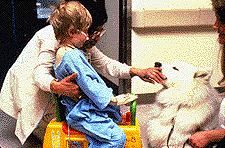
|

The Role of Nurses
|
Nurses have always been the advocates for patients. However, when referring pet therapy for patients, it is important for nurses to be aware of the guidelines and potential risk of pet therapy. According to the World Health Organization (as cited in Brodie et al., 2002), the Guidelines for nurses and others introducing pet animals into a health care facility is a helpful tool for nurses when incorporating pet therapy in patient care. The guidelines include three categories: careful selection of suitable pets and patients, veterinary care, and education for patients, visitors, and staff involved in pet therapy. Nurses should be aware of the possible health benefits to humans of companion animals and their role of advocating for the patient so that they can benefit from the therapy (Moody et al., 2002). Nurses can also take a leading role in the research and design of pet therapy programs in the health care setting which offer an exciting and legitimate way to help the patients to meet their needs (Miller & Connor, 2000).
|

|


